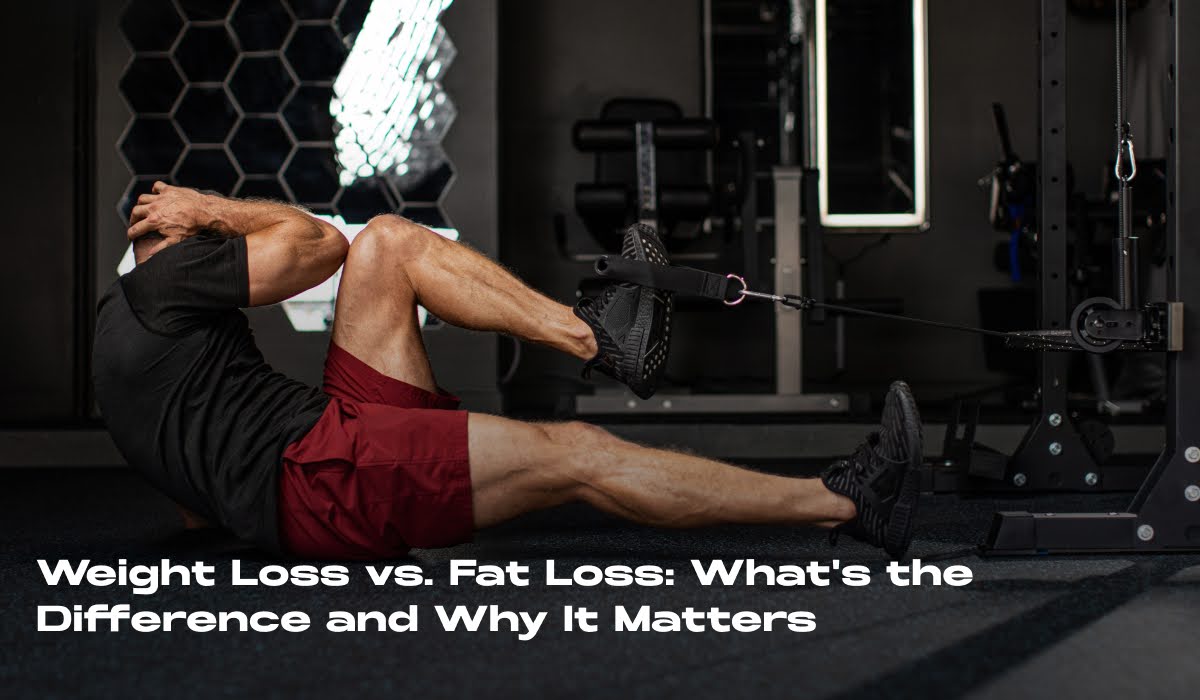To most, when it comes to getting fit and losing weight, the concepts "weight loss" and "fat loss" are interchangeable. The two terms, however, fundamentally differ in their connotations and effects. Although each is intended to lead you to a road of better health, the path to each and the final effect is dramatically different for someone planning or about to undertake a fitness regime, knowing which can mean learning how you will get where you want to go and how you will measure success. The article will further discuss the main differences: why you should lose fat first over weight loss and how to do it.
Weight loss and fat loss are not the same. While weight loss deals with the reduction of total body mass, fat loss deals with the decrease in body fat percentage, which keeps your muscle mass and aids you to have a better, sustainable body composition.
Weight Loss: What Is It?
Weight loss is the general reduction of the total amount of your body weight. It is the decreased contribution of everything that makes up your weight: fat, muscle, water, and bone density. People often relate weight loss with a few pounds less on the scale, forgetting what is lost.
Key Points About Weight Loss
The Scale Addiction:
For most, the first measure of Progress is the scale in the bathroom. Inexpedient and simplistic, it measures only part of the equation.
Accidental Muscle Loss:
Clients placed on calorie-restricted diets that do not consider the balance of macronutrients tend to lose muscle and fat. The loss of muscle slows the metabolism, making the client more likely to gain back weight as time passes.
Quick Gains, Long-Term Troubles:
Crash diets and over-cardio workouts are considered extreme weight loss measures; what is the rebound effect? Weight gain tends to occur once the diet is over because their metabolism has slowed.
The Intelligent Way of Fat Loss
Fat loss focuses particularly on reducing body fat percentages without losing muscle mass or even increasing muscle mass. This would lead to a leaner, stronger, and healthier body. A good way of measuring Progress is by noting changes in body fat percentage, measurements, or photos, which are better than just scale weight.
Key Discussion Points of Fat Loss:
Sustenance of Muscle:
Resistance training and adequate dietary protein will help sustain muscle mass during fat loss. This will create a sculpted silhouette and aid in having a higher metabolism.
Improved Health Indicators:
Weight loss through body fat loss has also been linked to several positive health markers, such as risks of heart conditions, diabetes, and hypertension.
Sustainable Changes:
The approach used in strength training, balanced nutrition, and moderate cardio to achieve fat loss is much more sustainable and reduces the chances of weight regain.
Why You Should Focus on Fat Loss Over Weight Loss
Whenever the primary goal is fat loss, you invest in a healthier and fitter body that will prove relatively more straightforward to maintain over time. Fat loss improves body composition while increasing muscle mass and obtaining a more aesthetic physique. Ironically, though, what it relates to concerning hitting a particular number on your scales is not how people become healthier and more confident. Instead, those focusing entirely on weight loss compromise their metabolism, muscle mass, and general health.
How to Achieve Fat Loss
To be able to successfully target fat loss, you should:
Incorporate Strength Training: Weight lifting or resistance exercises at least 3-4 times a week can help build and maintain your muscles.
Focus on Protein:
You must eat enough proteins to facilitate the growth and repair of muscles. You should consume about 1.2-2.2 grams of protein per kilogram of your body weight.
Create a Calorie Deficit, But Carefully: Eat fewer calories than you burn, but don't overdo it. Let your calorie deficit be conservative, so you lose fat slowly and steadily and preserve muscle.
Monitor Progress Differently:
Use body measurements, body fat percentage, or progress photos rather than relying on the number going down on the scale.
Why Fat Loss Needs to Come First
Improved Metabolism and Health:
Muscle tissues are metabolically active; they burn more calories resting than fat tissue. Therefore, resting metabolic rate improves if the goal is to lose fat and preserve or build the muscles. It has been established in several research studies that loss of fat instead of weight loss is associated with better cardiovascular health, risk of developing diabetes, and hormonal balance.
Aesthetics and Body Composition:
Two individuals can weigh the same on the scale but may appear different based on body composition. A person with a higher muscle mass percentage and relatively more minor body fat would become aesthetically built, well-toned, and fit-looking. On the other hand, the individual with less muscle mass and more significant body fat will have a softer and rounder body. That is another reason simple weight loss is unlikely to be satisfactory or fulfilling. Instead, focusing on body fat burn translates to a leaner yet more defined body.
Muscle Retention, Aging and Functional Advantages:
Dieting tends to burn muscle mass, which weakens you, decreases your energy, and heightens the possibility of injury. As you age, your body requires muscles to have continuous bone density for joint health and functionality. Hence, a vital part of losing fat is to retain resistance training along with sufficient protein intake.
How to Change Your Mindset to Burning Fat
To lose fat rather than weighing less, follow the step-by-step process that could be done:
You can only develop and sustain muscle strength if you exercise with strength training at least 3-4 times a week. You must eat a high-protein diet, as that protein will help you forget to represent. It keeps you feeling longer, reducing your cravings for the same food.
Cardio Only in Moderation:
While high for the heart, too much of this will result in many lost muscles instead. To burn more fat, you can choose more sessions of high-intensity interval training (HIIT).
Monitoring Body Composition and Not the Scale: Use body fat percentage measurements and progress photos. Improvement that even the scale alone will not show can be measured here.
Why Weight Loss Is Also Important After Fat Loss
After focusing on fat loss, it’s worth shifting attention toward gradual weight loss to achieve a more refined, healthier physique. Although fat loss provides significant health and aesthetic benefits, some individuals may still find that managing their overall body weight is essential for optimal health and performance. Weight loss, when appropriately approached after reducing fat levels, can enhance fitness, improve mobility, and potentially lower the risks associated with being overweight, such as joint strain and metabolic complications. This approach allows people to focus on achieving a weight that feels balanced, sustainable, and supportive of long-term wellness.
How to Achieve Weight Loss After Fat Loss
1. Fine-Tune Your Caloric Intake:With fat loss already addressed, the caloric deficit for weight loss can be even more modest. Aim to consume slightly fewer calories than you burn, focusing on nutrient-dense, whole foods. This slight deficit supports steady, sustainable weight reduction without the risk of burning through lean muscle mass.
2. Maintain Protein Intake:Continuing to consume adequate protein (1.2-2.0 grams per kilogram of body weight) is essential, as it helps preserve muscle tissue during weight loss and promotes satiety. The focus should remain on lean proteins that support energy without adding unnecessary calories.
3. Stay Active Through a Balanced Exercise Routine:After strength training becomes a habit, incorporating moderate aerobic exercise into your weekly routine can further aid weight loss. Cardio exercises, whether walking, cycling, or moderate running, help expend additional calories without overly stressing the body.
4. Prioritize Recovery and Sleep:Proper rest is critical, especially during weight loss. Quality sleep and recovery periods between workouts enable the body to repair muscles, balance hunger hormones, and reduce stress – all of which support sustainable weight loss.
Why Weight Loss is Essential After Fat Loss
1. Enhanced Mobility and Joint Health:
While fat loss alone significantly reduces the burden on joints and muscles, excess weight may still strain the body, particularly for individuals with high muscle mass but remaining fat. Achieving a balanced weight improves overall mobility, reduces joint stress, and supports a full range of motion.
2. Better Control Over Blood Pressure and Cholesterol Levels:
Weight loss beyond fat reduction can further improve metabolic health markers. Achieving a weight within a healthy range is often associated with lower blood pressure and cholesterol, as the cardiovascular system operates more efficiently.
3. Improved Energy and Endurance:
Lighter body weight makes daily activities and endurance-based exercises easier. Many find that even a slight reduction in overall body weight enhances their ability to stay active, which promotes long-term health.
4. Sustainable Fitness Goals:
Weight loss following fat loss allows for gradual, controlled improvements to physique without compromising muscle mass or strength. For many, maintaining an ideal weight and lean muscle composition translates to sustained fitness goals and consistent body satisfaction.
Mindset Shift: Embracing Weight Loss After Fat Loss
1. Avoid Extreme Calorie Deficits:With muscle mass preserved, the goal is not rapid weight loss but a sustainable, gradual reduction. Choosing nutrient-dense foods and avoiding strict calorie cuts prevents the pitfalls of extreme dieting.
2. Use Non-Scale Measurements as a Guide:Even during weight loss, continue using body fat percentage, photos, and measurements rather than obsessing over the scale alone. Seeing subtle improvements helps reinforce that weight loss is about enhancing overall wellness.
3. Stay Consistent with Strength Training:Resistance training remains crucial even as you focus on losing weight. It ensures the body retains strength and supports an active metabolism, which, in turn, makes weight loss easier and healthier.
4. Balance Your Cardio:Incorporating a mix of low-impact cardio with occasional higher-intensity intervals optimizes fat burning without risking muscle loss. Moderate cardio sessions provide benefits for heart health and endurance while supporting steady weight loss.
Conclusion
To seek a healthier lifestyle, you must first understand the difference between losing weight and losing fat. While losing pounds may provide short-term fulfillment of lower digits on the scale, focusing on fat loss will help you achieve the required fitness goals since it ensures the retention of muscle mass, increased metabolism, and general health. Then, by setting your sights on fat loss instead of just the loss of pounds, you're investing in a fitter, more vital, and healthier future.
So, the next time you set your goals, do not just set the objective of losing weight but rather an aim of losing fat!






Share:
Rehabilitation of Injuries with Two-Pulley System: An Approach without Risk
Quick Full-Body Workouts for Busy Professionals | Bullet Pulley